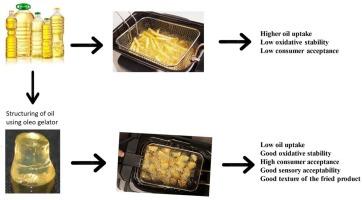Changing the horizon of food frying from the use of liquid oil to semi-solid gel
IF 7
1区 农林科学
Q1 FOOD SCIENCE & TECHNOLOGY
引用次数: 0
Abstract
Deep fat frying is the most adopted process of producing fried food products; it involves mass and heat transfer to form fried products with good colour, crispiness, flavour, taste, and texture. However, frequent consumption of these products is a concern due to higher oil content that poses threats to human health. Hence, there is a need to find an alternative frying medium for deep fat frying of food products to obtain fried products having lower fat content. The structuring of liquid oil to convert it into semi-solid gel by the process of oleogelation forms oleogel. The use of oleogel as a frying medium gives fried products with good oxidative, textural, and sensory attributes. The Oleogelator used in the formulation of oleogel plays a significant role in maintaining the stability of oleogel. An increase in the oleo gelator concentration decreases the oil uptake in the fried product. The superior product quality and high consumer acceptance of oleogel fried products indicate that oleogel is a potential frying medium. The scope of the present review is to cover the heat and mass transfer perspective of the deep fat frying process, factors responsible for oil uptake in fried products, formulation and components of semi-solid system, discussion on various characteristics of semi-solid system as frying medium, comparative assessment of oil uptake in food fried in oleogel and conventional oil and finally covering specific examples showing the efficacy of liquid oil oleogel as a frying medium.

从使用液态油到半固态凝胶,改变食品煎炸的视野
油炸是生产油炸食品最常用的工艺;它涉及质量和热量的传递,使油炸产品具有良好的色泽、酥脆度、风味、口感和质地。然而,由于油脂含量较高,经常食用这些产品会对人体健康造成威胁。因此,有必要寻找一种替代油炸食品的油炸介质,以获得脂肪含量较低的油炸产品。通过油凝胶化过程将液态油转化为半固态凝胶,就形成了油凝胶。使用油凝胶作为油炸介质可使油炸产品具有良好的氧化性、质地和感官特性。配制油凝胶时使用的油凝胶剂对保持油凝胶的稳定性起着重要作用。油凝胶剂浓度的增加会降低油炸产品的吸油量。油凝胶油炸产品的卓越产品质量和较高的消费者接受度表明,油凝胶是一种潜在的油炸介质。本综述的范围包括油炸过程的传热和传质角度、造成油炸产品吸油的因素、半固态系统的配方和成分、讨论半固态系统作为油炸介质的各种特性、比较评估油凝胶和传统油炸食品的吸油情况,最后以具体实例说明液态油脂凝胶作为油炸介质的功效。
本文章由计算机程序翻译,如有差异,请以英文原文为准。
求助全文
约1分钟内获得全文
求助全文
来源期刊

Food Research International
工程技术-食品科技
CiteScore
12.50
自引率
7.40%
发文量
1183
审稿时长
79 days
期刊介绍:
Food Research International serves as a rapid dissemination platform for significant and impactful research in food science, technology, engineering, and nutrition. The journal focuses on publishing novel, high-quality, and high-impact review papers, original research papers, and letters to the editors across various disciplines in the science and technology of food. Additionally, it follows a policy of publishing special issues on topical and emergent subjects in food research or related areas. Selected, peer-reviewed papers from scientific meetings, workshops, and conferences on the science, technology, and engineering of foods are also featured in special issues.
 求助内容:
求助内容: 应助结果提醒方式:
应助结果提醒方式:


